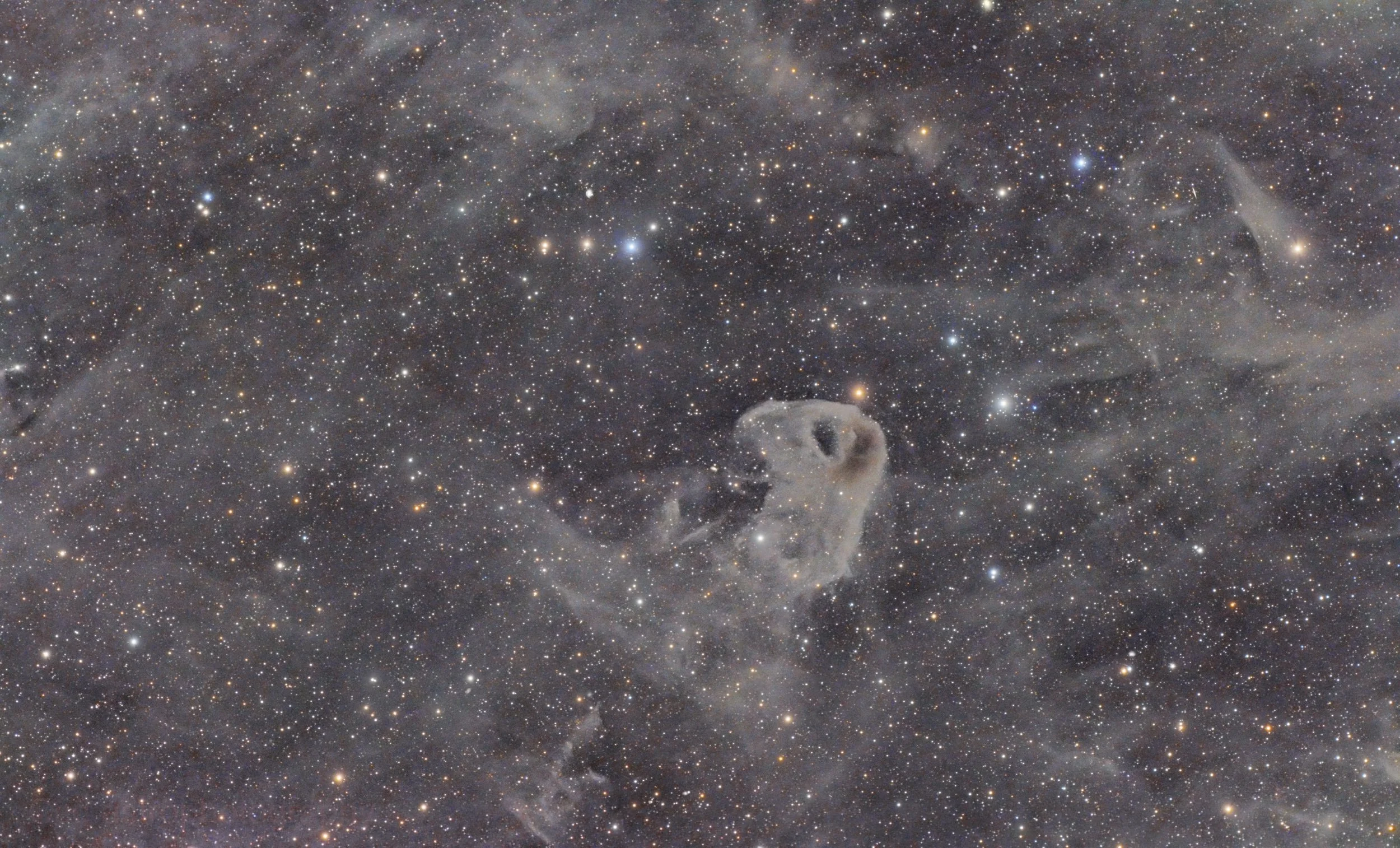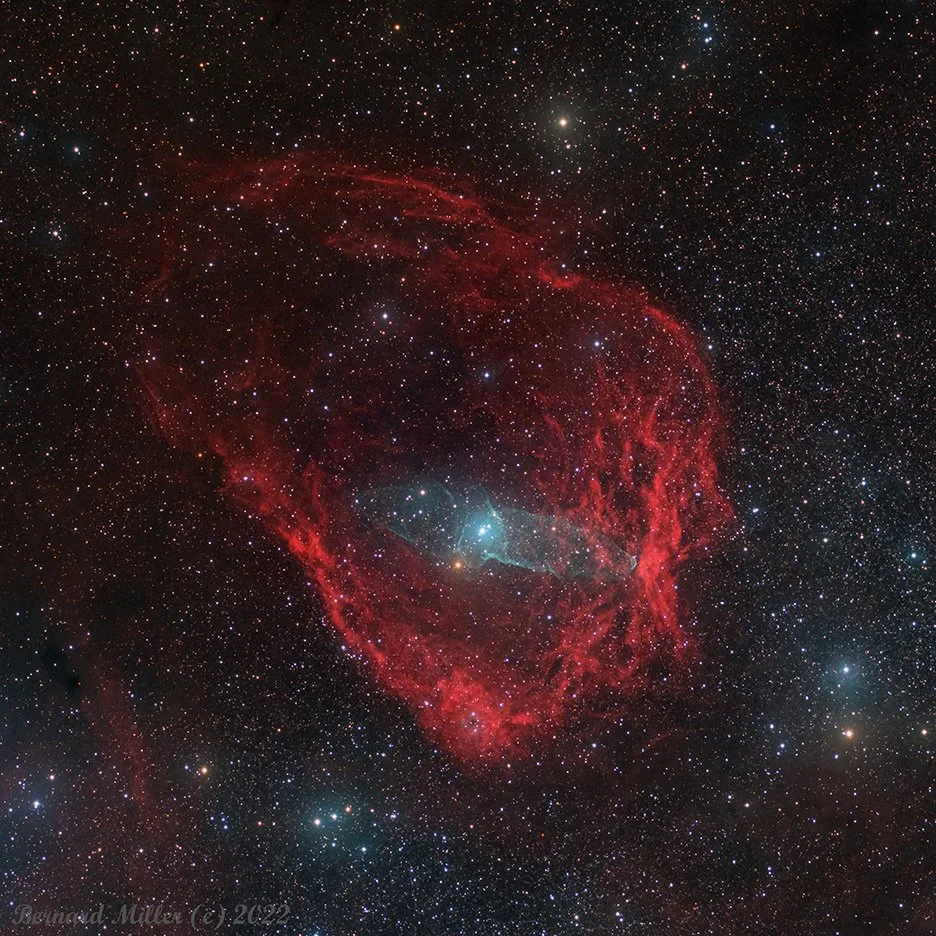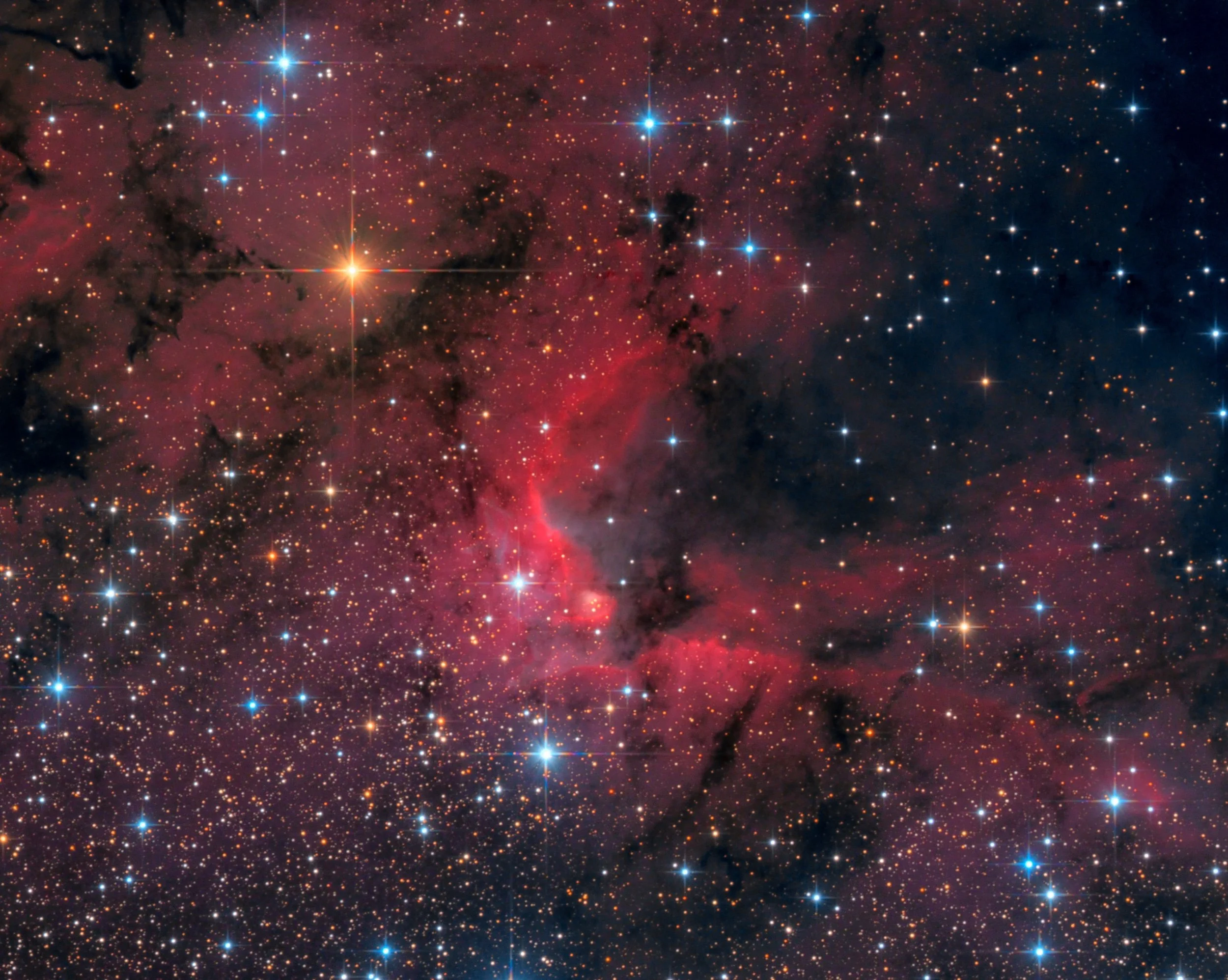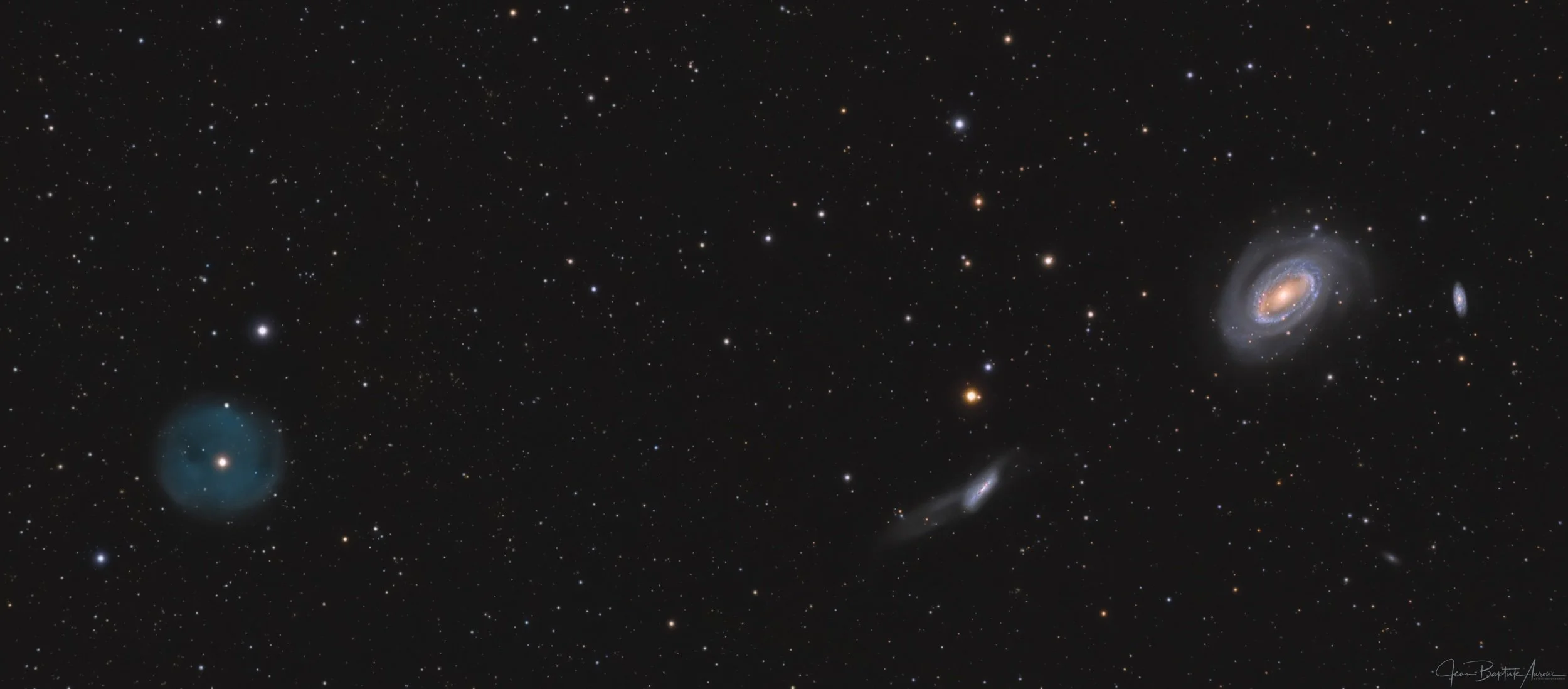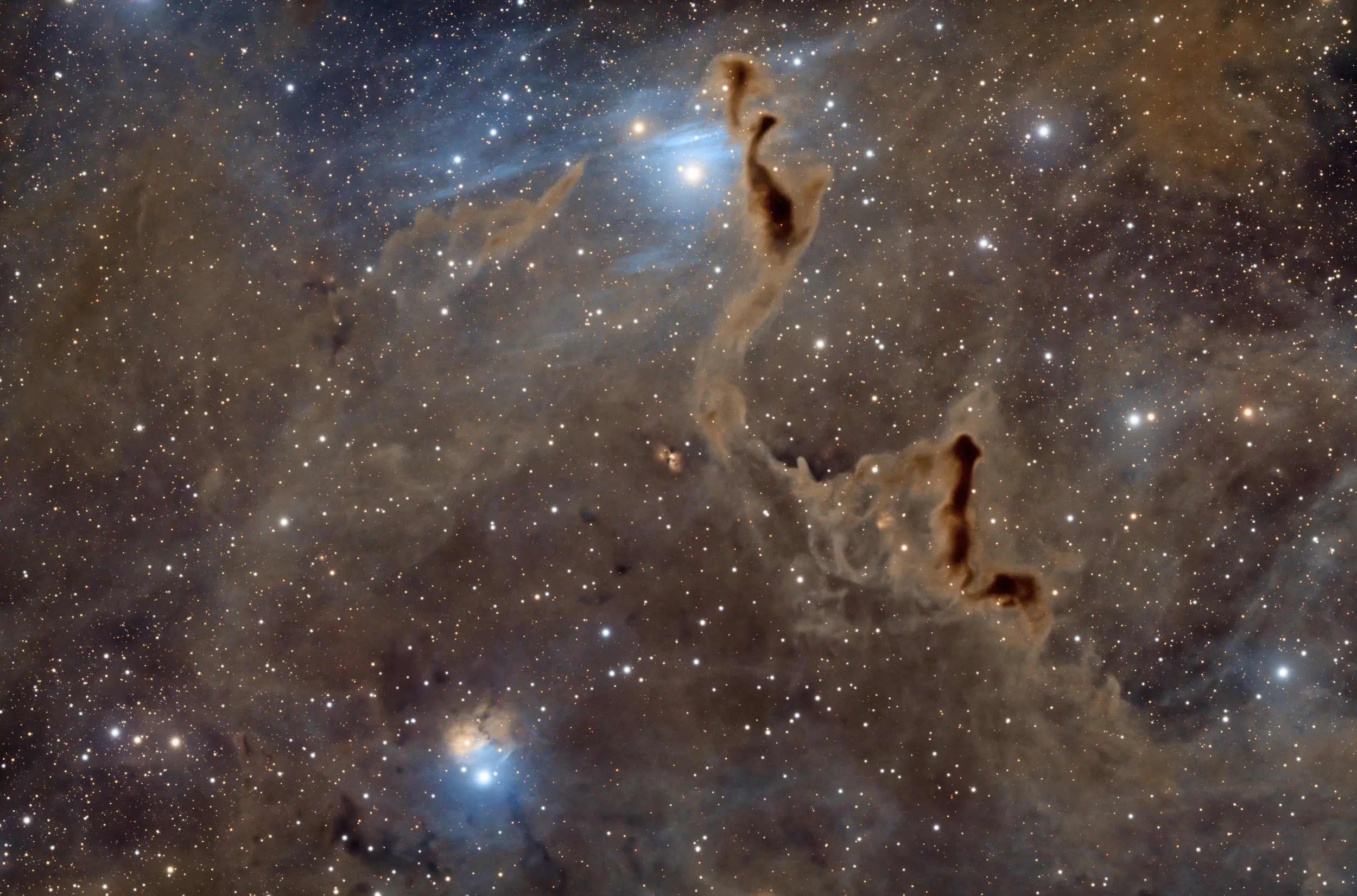
AAPOD2 Image Archives
Cassiopeian Heart
Image Description and Details :
Data Acquired from: Telescope live.Location: IC Astronomy Observatory, SpainScope: Takahashi FSQ-106ED (106 mm) F3.6Focal Reducer: 0.73Mount: Paramount MX+Astrodon SHO FiltersTotal Integration Time: 24 hrs. 50 minsProcessing in Deep Sky Stacker, Pixinsight, Photoshop
Copyright: Basudeb Chakrabarti
Jellyfish, Monkey Head, and M35 Star Cluster
Image Description and Details : Here is my latest photo taken night before last in the back yard. It is featuring the Jellyfish in HOO palette , the Monkey Head in SHO palette , and Star Cluster Messier 35 in RGB. The nebulosity was captured using narrowband filters that only let specified wavelengths of Sulfur, Hydrogen, and Oxygen. The stars were captured with color separate filters for Red Blue and Green. I used a Rokinon 135mm camera lens at f/2 and an ASI294MM dedicated monochrome camera.20 x 60 seconds of each L R G B 36 x300 seconds Oiii 24 x 300 seconds Sii 16 x 300 seconds HaShot Flats for all filters this morning and used my darks library. Stacked and Processed with Pixinsight and Photoshop. EZ soft stretch Starnet Automatic Background Extraction Background neutralization Save separates as Tif’s for Photoshop Copy S H and O in to RGB color channels and work levels and curves. Adjust selective colors to reduce green and pull the Hubble gold color forward. Contrast Brightness adjusted Saturation adjusted. Resize down to 2,048 pixels wide. Topaz denoise and upload.I am still learning Pixinsight. I used selective colors in Photoshop to attempt the Hubble palette colors evident in the Monkey Head. Finally I resampled to 2048 pixels wide for sharing as a Jpg and did a topaz denoise. Hope you enjoy it.
Copyright: Abe Jones
Baby Eagle Nebula
Image Description:
This image contains a small part of a very dusty region in the constellation Taurus.
Main target is Baby Eagle Nebula (Lbn 777) but there is many other small galaxies in the frame so a bit of a zoom will do the trick
The image was done with two cameras and has a total integration time of aprox. 16 hours.
rgb 137 x 180sec with Qhy 268c,high gain mode ( gain 102 offset 76 )
Ha 170 x 180sec with Qhy 268m,high gain mode (gain 56 offset 25 )
Apt for acquisition,alligned and stacked with ccd_stack 2 and processed in Pixinsight.
EQ8_PRO Mount,
Tak FSQ-85EDX f/5.3 telescope ,
SG-4 standalone autoguider and a Borg50 guidescope
from my backyard in Bedfordshire.
Copyright: Cosar Catalin Daniel
The Flying Bat and Squid Nebulae
Image Details:
Location: Oria, Almeria, Spain
Telescope: Takahashi FSQ-106EDX4
Camera: FLI PL16803
Mount: Paramount MX+
Ha: 10x10 minutes (binned 1x1)
OIII: 80x10 minutes (binned 1x1)
RGB: 8x10 minutes each (binned 1x1)
Copyright 2022 Bernard Miller
ic405/ic410/ngc1931- 3 panels mosaic
Image Description and Details :
3 images are combined (32% original size)image 1 : 3 panels mosaic (taken with e-180/ASI094MC)image 2 and 3 : high resolution images (taken with RC10/SX-H694)Date : 8Dec.2021 -16 Dec.2021Place : Gemini Remote Observatory, Lijiang, Yunnan, ChinaTelescope : Tak e-180 ,Mount : Skywatcher EQ8Camera : ZWO ASI094MC(-10ºC ) ,Filters : Baader Ha,LExposure : panel 1 (ic 405 /upper ) L: 180sx 44 , Ha:900sx 6panel 2 (ic 410/ middle) L: 180sx 42 , Ha:900sx4panel 3 (ic 417/ngc1931 lower) L: 180sx 50 , Ha:900sx6(total~ 10.8hr)Guiding : Borg 50 / asi174 ,Image Processing : PI ,PS-CC
Copyright: Alan Van
NGC 1999 Reflection Nebula
Image Description and Details :
One of the first images taken after NASA astronauts repaired the Hubble Space Telescope in December 1999, was NGC 1999, a nebula in the constellation Orion. While the Hubble image was much deeper than the image presented here, it nevertheless generated a lot of interest amongst astronomers. NGC 1999 is an example of a reflection nebula. Like fog around a street lamp, a reflection nebula shines only because the light from an embedded source illuminates its dust; the nebula does not emit any visible light of its own. NGC 1999 lies close to the famous Orion Nebula, about 1,500 light-years from Earth, in a region of our Milky Way galaxy where new stars are being formed actively. NGC 1999 was discovered some two centuries ago by Sir William Herschel and his sister Caroline, and was catalogued later in the 19th century as object 1999 in the New General Catalogue.Total Integration 24h40mLum 14x20m=4h40mRed 14x20m=4h40mGreen 14x20m=4h40mBlue 17x20m =5h40mHa = 10x30m=5h00m
Copyright: Vikas Chander
Orion Constellation & Barnard loop
Image Description and Details :
Here is my post on this Orion photo and the Barnard loop, I spent the only clear night without a moon to try the samyang 135mm f2, because I wanted to have fun doing astrophotography. I absolutely wanted to shoot the constellation of Orion and the loop of Barnard. It was complicated to image it with a more than hazardous seeing but on 210 shots of 120 seconds I kept only 100 raw. After processing tests, I was happy with my final treatment.
Samyang 135mm at f2.8Canon 6D Iso 1600 Photomax Heq5 pro100 brutes x 120''Copyright: Oliver Globetrotter & P. Bernhard
Abell 30
Image Description and Details :
Abell 30 is a small (127 arc seconds) extremely faint planetary nebula located approximately 5,500 light-years away in the constellation of Cancer. Abell 30 is one of just three known nebulae called born-again planetary nebulae. Very rarely, nuclear reactions within the vicinity of a white dwarf can heat the gases to such high temperatures that the tiny star briefly becomes a red giant once more. This is a very brief phase, lasting a mere 20 years or so. The original nebula is estimated to be around 12,500 years old (which in itself is very brief in astronomical terms). The tiny features in the centre of the bubble are evidence of this re-birth. They are most probably comprised of helium and carbon-rich materials and were ejected around 850 years ago.The Ha signal is a featureless disk. All of the structural detail comes from the OIII signal. Image captured on my remote dual rig at Fregenal de la Sierra in Spain between 14 December 2021 - 9 January 2022.Scopes: APM TMB LZOS 152 Refractors Cameras: QSI6120wsg8Mount: 10Micron GM2000 HPSA total of 102 hours image capture (HaOIIIRGB)
Copyright: Peter Goodhew
Supernova remnant IC443-444
Image Description and Details :
Image captured during 7 nights from bortle 9 backyard. Total exposure time of 38h with individual subframe of 10min for each filter SHO.Also included data from Chandra telescope to enhance the xray area in the center of ic443 where there is a neutron star probably leftover from the supernova.
Copyright: Riccardo Pacini
The Hidden Galaxy
Image Description and Details :
IC 342 or the Hidden Galaxy in the constellation Camelopardalis gets its name due to its location in the dusty areas near the Milky Way galactic equator.This image was obtained thought a Meade LX850 12" telescope with QHY268m camera and Chroma filters.Integration time is 12.50 hours (Lum 53x300", Red 24x300", Green 24x300", Blue 24x300" & Ha 12x600")
Copyright: Fabian Rodriguez Frustaglia
Heart of the Heart Nebula
Image Description and Details :
Our first picture with our remote imaging setup in south Portugal (Alelentejo Remote Observatory managed by the ARO TEAM).
Our team named AstroDarkTeam is a team of two passionate french amateur astronomers : Stephane Rolland and Pascal Gouraud
We have installed our setup in south Portugal (EQ8-R + TOA130) on mid-october 2021 and we have been imaging since end of October 2021.
Our first target is IC1805 an emission nebula and star cluster Melotte 15.
Clouds in this area are sculpted by stellar winds and radiation from massive hot stars in the nebula cluster, Melotte 15 (about 1.5 million years young).
This 15 light-years wide field view includes emission from ionized hydrogen, sulfur, and oxygen atoms.
The Heart Nebula. IC 1805 is located about 7,500 light years away toward the constellation Cassiopeia.
Regarding imaging sessions, We have got some issues with thermal amplitude and humidity.
Some improvements still to be done regarding subframe exposure (moving to 15 or 20 minutes) and better subframe selection.
Regarding processing, we have been unable to integrate LRVB shots to improve star colors, so still to be improved for future pictures.
For a first run, we are quite happy with this result.
Copyright: Pascal Gouraud / AstroDarkTeam
Variable stars in the Pleiades cluster
Image Description and Details : There are a lot of variable stars in the Pleiades cluster. About 60 were identified in this view using the AAVSO star charts.
4 of those showed clear variability in my recordings of 9-1-2022
NSV 1300. which is of type BY Draconis variables. These are rotating variables, usually type K or M, so orange/red stars. What you see here are starspots (sunspots on a star) spinning in and out of view. It revolves in 4.5 hours and you see almost 2 laps.
V1188, is an eclipsing binary star with a period of 13.88 hours. It varies between 12.3 and 11.85.
YZ Tau also shows variability. This is an RR Lyrae type variable. with a period of 9 hours. These are pulsating stars that shrink and grow periodically.
Here you can already see a contraction (getting hotter) and expansion (getting colder) of the star.
OU Tau is also a BY type star, a rotating star with a stellar spot on it. It rotates in 9.5 hours. In this case you can already see 1 cautious dip when the starspot rotates in and out of our image
Copyright: Remco Kemperman
Sh2-155
Image Description and Details :
Sh2-155 (also designated Sharpless 155 or S155) is a diffuse nebula in the constellation Cepheus, within a larger nebula complex containing emission, reflection, and dark nebulosity. It is widely known as the Cave Nebula. Sh2-155 is an ionized H II region with ongoing star formation activity, at an estimated distance of 725 parsecs (2400 light-years) from Earth.
Copyright: Sergiy Vakulenko
Solar Analemma
Image Description and Details :
A year-long project done! Here’s the product of several days of taking photos of the Sun from the same spot at the same time throughout the year and combining these images into one striking photo.
It’s called an analemma, a diagram of the Sun’s position in our sky that varies over the course of the year because of our planet’s tilt and elliptical orbit.
The loops resembling the figure of 8 actually represent the seasons we experience here in the Northern Hemisphere: the narrow loop shows where the Sun is traveling in our sky during the summer months (June-early September), while the bigger loop shows the position of the Sun during the winter months (December-early March).
I took the 43 photos of the Sun that made up this composite image. These were taken every week from January 9 to December 25, 2021, with the Ak Sadeem Observatory as the foreground element. Post-processed in Photoshop 2020.
Equipment used: Canon Ra DSLR, Tamron 14-24mm lens, Baader solar filter. Abu Dhabi, UAE.
Copyright: Aldrin B. Gabuya/Al Sadeem Observatory
Sh2-129 / OU4 / Barnard 150
Image Description and Details :
This image has been made from 343 hours of exposure through broadband (LRGB) and narrowband (H-alpha & OIII) filters, composed as an 8-panel mosaic. The result covers an area of approximately 3.50° x 5.10° at 2.09 arc''/pixel resolution. Placed on the surroundings of the constellation Cepheus, this area is rich in several DSOs: We can see Sh2-129, also known as the Flying Bat Nebula, a large and faint HII region showed here in its characteristic H-alpha deep red line.
Superposed to Sh2-129 we see the even fainter Ou4 nebula, colloquially the Giant Squid Nebula, discovered in 2011 by Nicolas Outters, a French amateur astronomer. At first identified as a planetary nebula emitting in the OIII blue-green doublet, it would be in fact the largest in apparent size yet identified, extending over one degree (Acker et al. 2012 - arXiv:1206.2477). However, Corradi et al. (2014 - arXiv:1407.4617) describe Ou4 as the result of a bipolar outflow emanating from a massive component of HR 8119, a triple system located 2,300 light-years away, thus about as far as Sh2-129. If confirmed, this would make it a truly perplexing object.
On the right side of this image appears Barnard 150, or Seahorse Nebula, a dark nebula distant 1,500 light-years, composed by three dense star forming cores, part of an elongated molecular cloud complex. Finally, close to the lower-left end we have identified HD 203025, a Be type star surrounded by a diffuse red nebulosity, captured here through the H-alpha filter. It was catalogued according to its colour and morphology as an IR centred nebula by Bodensteiner et al. (2018 - arXiv:1806.01294), resulting from a massive star member of an interacting binary system.
Technical data:
Telescope: Takahashi FSQ106 ED 530mm f/5
CCDs: QSI683 wsg8
Filters: Baader Planetarium -LRGB Ha OIII
Mount: 10Micron GM1000 HPS
Imaging Software: Voyager
Processing Software: Astropixel, Adobe PS, PixInsight
Imaging Data:
8-panel mosaic captured through July 2021 to December 2021
RGB: 170 x 600” (each). Total 84 hours.
Luminance: 280 x 900”. Total 70 hours.
Ha: 316 x 1200”. Total 106 hours.
OIII: 165 x 1800”. Total 83 hours.
Total Project : 343 hours
Copyright: Remote Observatory "FarLightTeam"
Team: José Esteban, Jesús M. Vargas, Bittor Zabalegui, Marc Valero.
Cosmic perspective : NGC 4725 Group & LoTr 5
Image Description and Details :
Here is a mosaic of 2 images with the main galaxies of the group NGC 4725 (located at about 55 million light-years) and the planetary nebula LoTr5, discovered in 1980 and located "only" at 1650 light-years from us!
The small galaxy NGC 4712, to the right of NGC 4725, is located more than 200 million light-years away.
A beautiful "cosmic perspective" with these different objects!
Mosaic of 2 images in LRGB + OIII. !
The framing of the first image was not intended for a mosaic with the nebula field, so an important part of the final field had to be cropped. The difference in sky quality resulted in a poor homogeneity of the sky background and a difficult connection between the two images, which did not facilitate the processing of this one.
A lot of time spent on processing to achieve a homogeneous result and highlight the nebula.
LRGB+OIII version
TSA102 - AtikOne6.0 - AZEQ6
L : 32 x 600s bin 1
RGB : 72 x 300s bin2
OIII : 18 x 600s bin2
Total : 14h20
Copyright: Jean-Baptiste Auroux
The Spaghetti Nebula -SIMEIS 147- SH2-240
Image Description and Details :
It took me 2 months to acquire enough lights to make anything out of it.
Indeed, I shot 14 winter nights between November and January (5 of which played with my nerves with the fog lifting at nightfall without being able to do anything).
So I shot from the Vosges, I camped in 0 ° C in Alsace, I shot from my astrobro Christope in Moselle, I went south of France to Valensole and I moved on several spots on several nights in this region.A total of 3,600 km of road to acquire the 55 hours of lights retained which consist of:
Tile 1:
Ha -> 71x600 ’’
Oiii -> 78x600 ’’
R G B -> 90x10 '' per filter
Tile 2:Ha -> 94x600 ’’
Oiii -> 78x600 ’’
R G B -> 90x10 '' per filter
While the acquisition was long and complex, so was the processing, I had to work with 400GB of data for a final image of 15 000 x 12 000px.Suffice to say that the PC has smoked!
Once again a big thanks to Christophe who illuminated me with his advices during the processing and gave me invaluable help, thanks also to Nico for his always correct eye!
Technical part:
Takahashi FSQ106 EDX4 with 645-QE super reducerAsi 2600MM Pro
Barilla (Antilla) RGB + H and O 3nm filters
Eq6r-pro
Altaïr 60/225 guide + asi 290mm mini
Sky bortle 3-4
Acquisition: N.I.N.A + Phd2
Processing: Siril + PixInsight + Photoshop
Taken in several parts of France between 2021/11/10 and 2022/01/03
Copyright : Yann SAINTY
IC434 Horsehead nebula
Image Description and Details :
Tak FSQ-106ED F/5SBIG STF-8300M + QHY CFW3 Filter wheelAstrodon L Channel 180sec x 116, 1binAstrodon H-a, R, G,B each Channel 300sec x 50, 1binBias, Dark, Flat processedOrion CT80 + ZWO ASI 120miniFLI Atlas focuserSkywatcher EQ8 mount (with EQ Drive standard4 TCS)
Copyright: Kim Young Dae
NGC 2442
Image Description and Details :
NGC 2442 is located around 50 million light-years away in the constellation of Volans. The galaxy is 75,000 light-years wide and has quite an peculiar shape featuring two dusty spiral arms extending from a central bar that gives it a hook-like appearance. Given its appearance it is often referred to as “The Meat Hook Galaxy.” The galaxy’s distorted shape is most likely the result of a close encounter with a smaller galaxy some time in the past. A considerable amount of IFN is present in the field proximate to the galaxy and the image shows faint star streams at the ends of the arms of the galaxy.Imaged in LRGB and H alpha OTA CDK 1000 Luminance, RGB and H alpha. Additional RGB RiDK 500.Imaged at Observatorio El Sauce, ChileIntegration time: 47 hoursImage Processing: Mark Hanson and Mike Selby
Copyright: Mark Hanson_Mike Selby
A Helping Hand in Cassiopeia
Image Description and Details :
This image shows a marvelous and busy area in the constellation Cassiopeia. It contains a large amount of dust, several dark nebula and several reflection nebula along with two interesting stars. Near the top center is the star SU Cassiopeiae which is a Cepheid variable at Mag 5.94. SU Cass is a Yellow giant with a spectral class of F5:lb-11. It's 19 times larger than our sun. SU Cass lies 1289 light years distant. Surrounding it is the blue reflection nebula VdB 9 which is lit up by SU Cass. The blue wisps extend quite a ways around this area. The other interesting star in the lower center left is the star RZ Cassiopeiae. RZ Cass is a white A3V main sequence star at mag 6.26. It's an eclipsing variable star which is 219 light years distant. The bluish nebulosity surrounding it is listed as VdB 7. However RZ Cass is apparently not the source to light up VdB 7 but another smaller 11th mag star nearby. Several dark nebula are right of center in the image. The upper part of this nebula looks like an opened hand, hence the nickname (The helping hand). The dark area of the hand, near the top finger is designated as LDN 1357 and below it near the palm, LDN 1355. The long dark area near center right is the dark nebula LDN 1358. Throughout this entire area encompassing the field of view is lots of molecular dust of varying thickness and color. This image was taken under the dark skies of the Okie Tex Star Party in October 2021. It encompasses 14.3 hrs of exposure time using LRGB filters.Scope: Stellarvue SVX 152T, Camera: ZWO ASI 6200mm Pro, Mount: Paramount MyTExposures: Luminance 59@300sec, Red 39@300sec, Green 38@300sec, Blue 36@300secProcessing: PixInsight
Copyright: Jonathan Talbot



